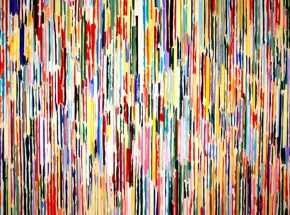

Thinking about how we, as humans, universally interact with fabric as a material, I deconstruct and reconstruct everyday clothing, sheets, curtains, and other previously used domestic fabrics. To create forms and environments, I use the repetitive processes of tearing, cutting, tying, and sewing. My manipulation infuses the fabric with an original form and function. I intentionally use fabric and clothing that has a history—specifically collecting clothing, sheets, and scraps from people I know. Each article comes to me infused with a narrative, marks of its previous owner, and unique material characteristics– holes, stains, dried out elastic. The fact that each piece of clothing came from someone I know allows me to individually connect with the article.
Clothing serves many purposes. The first and most obvious is the need to protect the body—comfort, warmth, etc. Its primary and most essential function is the creation of an immediate shelter. Every culture, throughout history, has also used clothing to signify monumental events—wedding dresses, funeral dress, school uniforms, military uniforms, etc. Each person, no matter what culture or country, interacts with clothing. And therefore, the subcategories of clothing become more specific, yet, are universal. As Barthes explores in The Language of Fashion, clothing and its design mirrors the ebb and flow of culture, both economically and politically. Clothing becomes a signifier of identity, class, culture, and historical decades. Clothing is used to indicate individuals, or create a unified group.
Clothing also serves a more personal function. Shirts, pants, sweatshirts, suits and dresses become “favorites,” and take on strong associations to the individual. The smell of the fabric or touch of the material can trigger a flood of personal memories of specific events or intimate moments. Throwing on a favorite t-shirt or keeping the sweater of someone who has passed, are ways of connecting to comfort and memory through material.
My recent work started as a collection project. I requested donations of clothing from anyone and everyone interested. With no specific parameters, the donations ranged from discarded, beat up t-shirts to bridesmaid dresses, etc. Knowing that each piece was chosen by someone and specifically sent to me for my installations sets up a history and connection to the articles I am manipulating. Each piece was worn by someone, maintains a history, and tells a story— a sari from a wedding dowry, Malawian traditional dress, favorite biking shirt, clothes that don’t fit because of weight loss, etc. These installations, however, are not an illustration of individual narratives. The general narrative, of collection and universal signifiers, takes precedence in the work. They quite literally are a web of narratives—mixing together, overlapping, and building on each other to create a social network and physical representation of personal connections and memories. Formal decisions—line, color, and shape—are dictated by the amount of fabric in each article. The structure of the piece is determined by the kind of fabric used— jersey, linen, cotton, polyester, etc. Depending on the type of weave, some pieces are more elastic, creating more tension, and others do not stretch.
My manipulation—deconstructing and reconstructing into an environment and space—facilitates a new interaction and evokes a sense of being surrounded, protected, and enveloped by clothing. Concepts of space in association to memory are activated in the experience of the piece. The spaces found by interacting with the installation are reminiscent of childhood forts, safe spaces—nooks, corners, attics, etc. In The Poetics of Space, Bachelard expands on the strong associations between space and memory. My installations are an embodiment of the memories associated with the donated clothing, an activation of personal memories, and creation of new associations with material and space.
-Victoria Greising
Website
http://www.VRGreising.com
